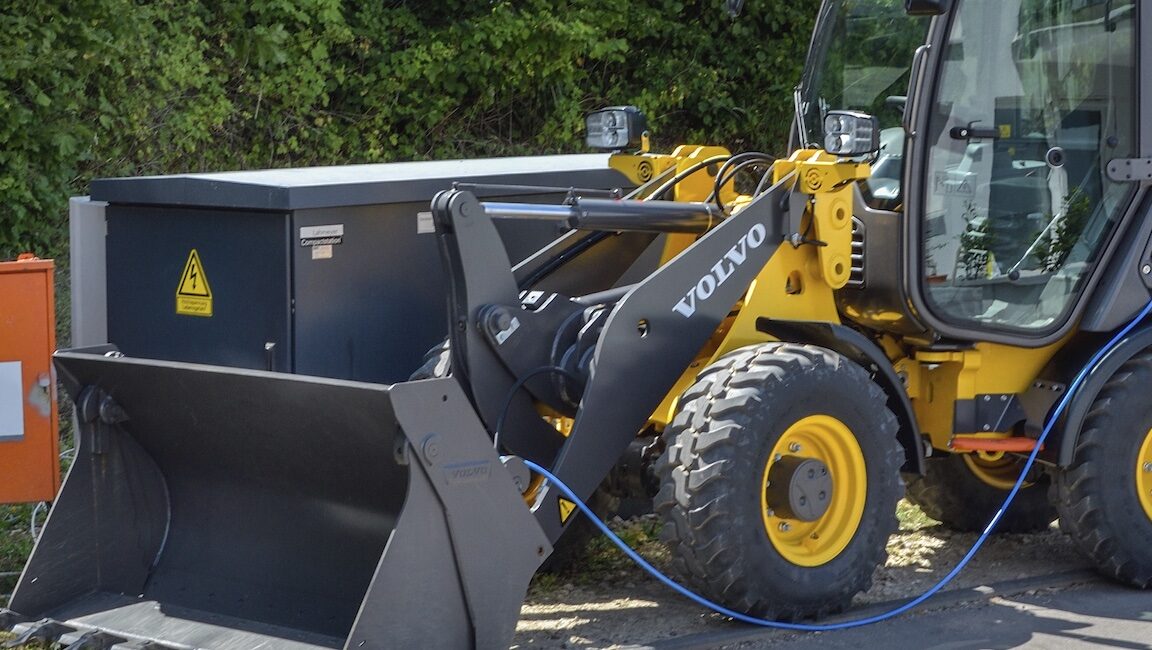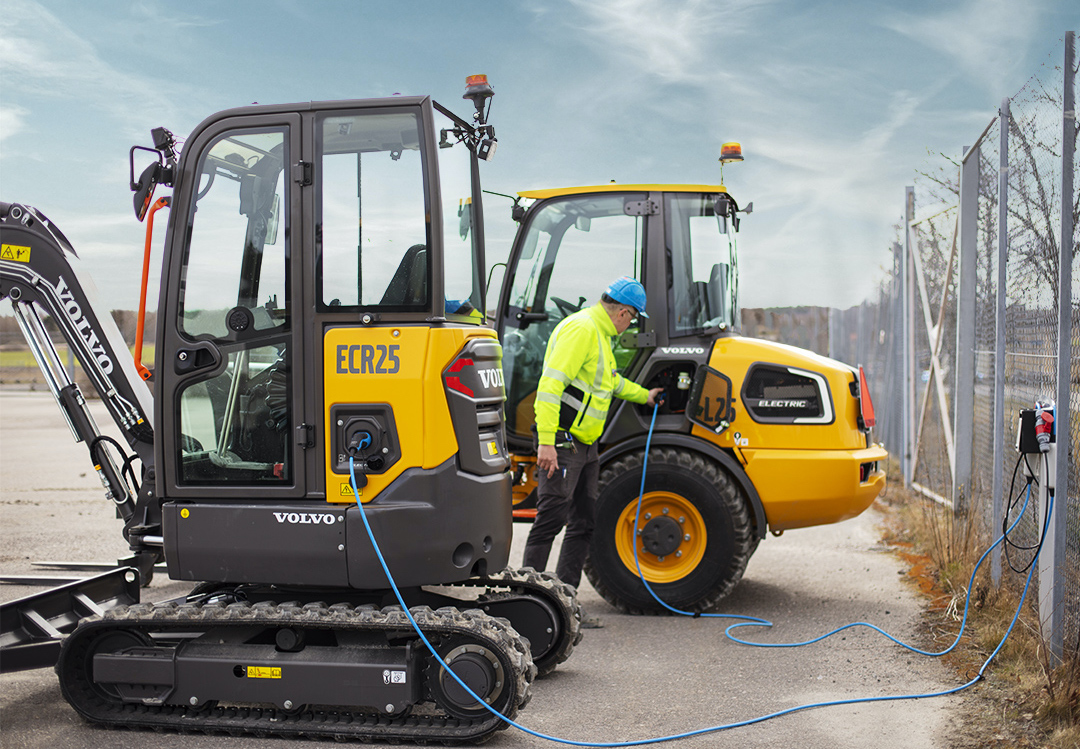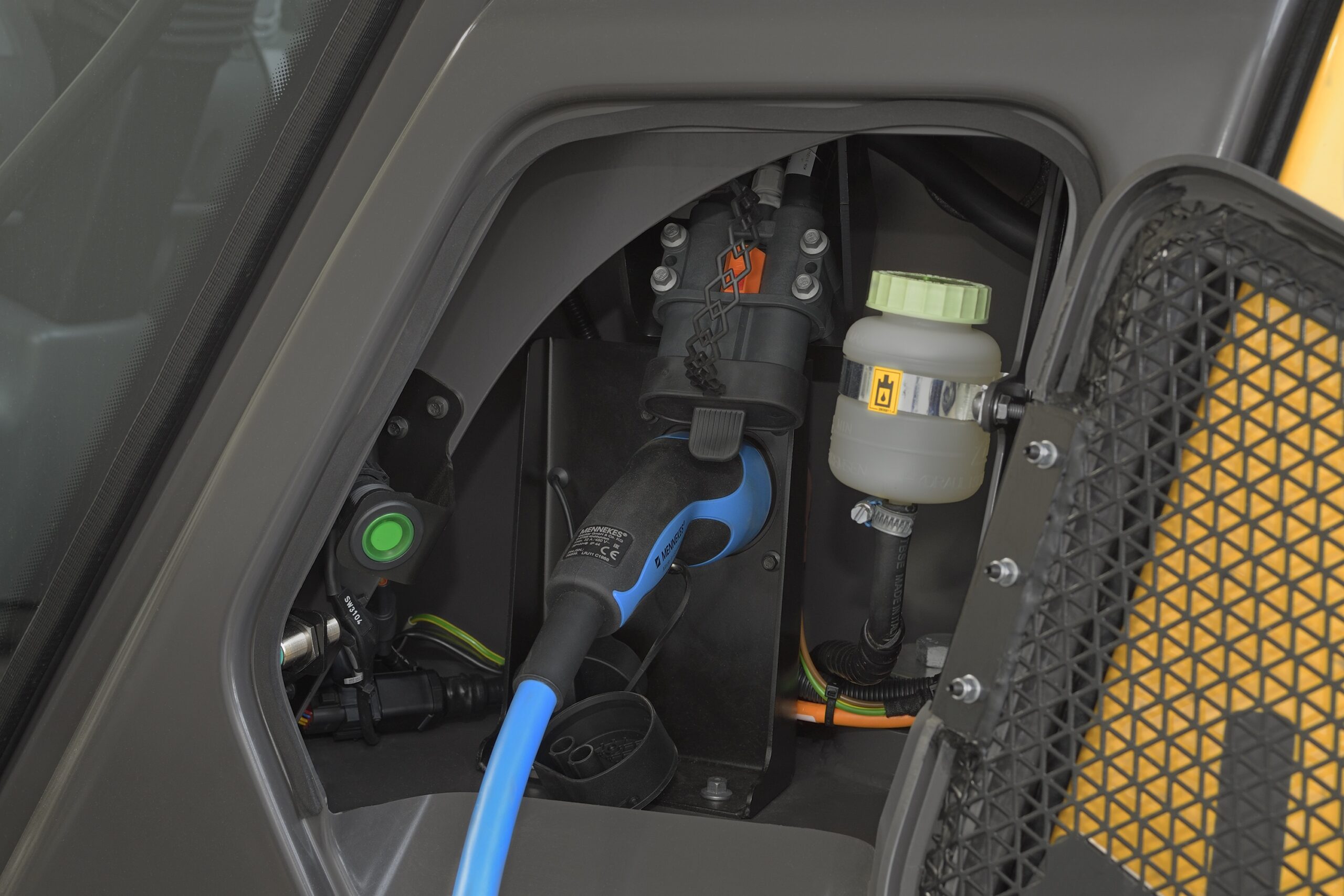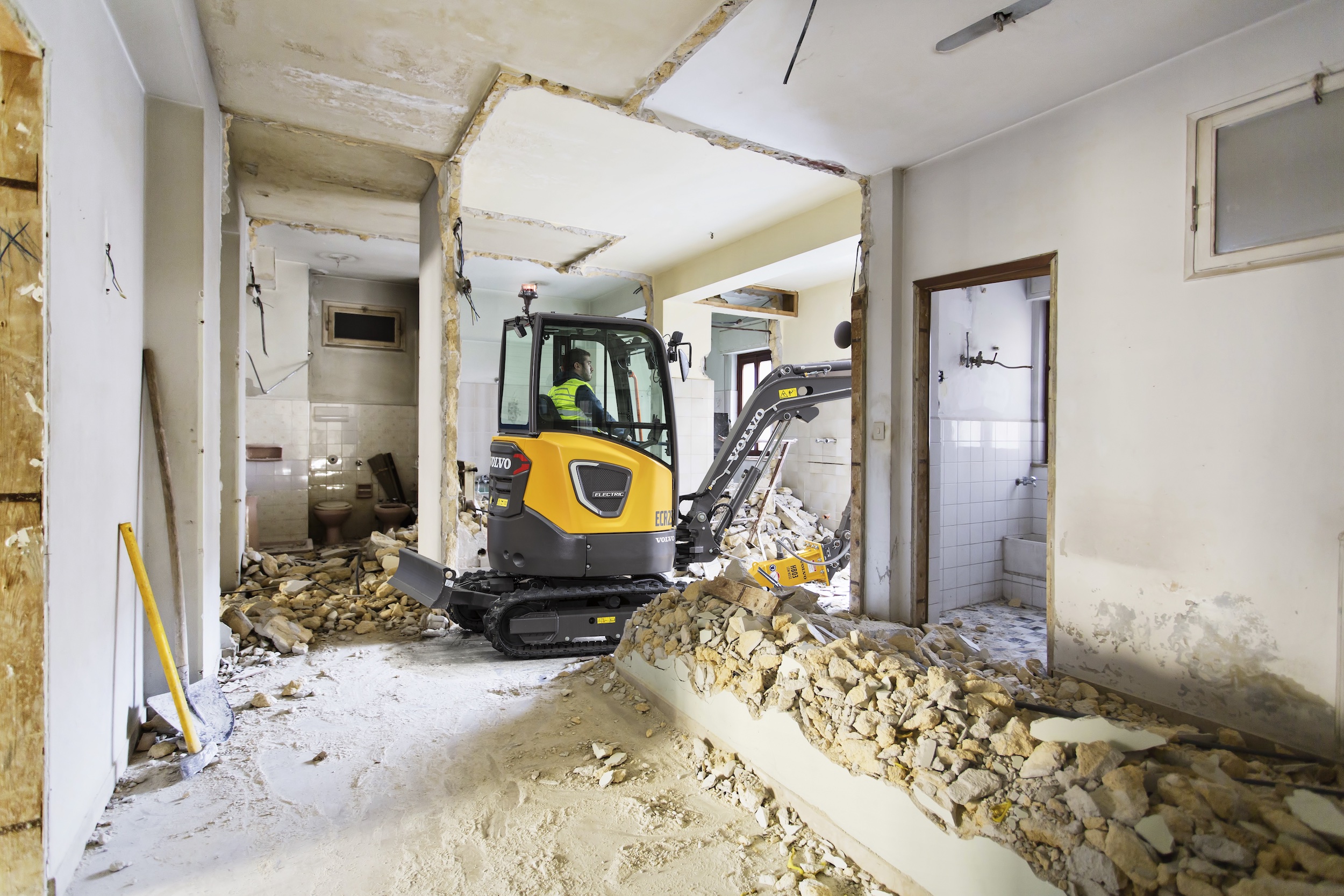
What type of charging infrastructure do I need for electric construction equipment?
To have an optimal charging time for electric machines, we strongly recommend a 240-volt NEMA 14-50 outlet utilizing an SAE J1772 charging adapter or J plug — the same as for electric cars. While you can charge the machines on a common household 120-volt network, it takes longer.
Here are the approximate charging times for the two setups:
| Common Household 120-Volt Outlet | 240-Volt, Level 2 AC Setup | |
| ECR25 Electric Excavator | 12 hours | 6 hours |
| ECR18 Electric Excavator | 11 hours | 5 hours |
| EC18 Electric Excavator | 12 hours | 6 hours |
| L25 Electric Wheel Loader | 24 hours | 6 hours |
| L20 Electric Wheel Loader* | 24 hours | 6 hours |
All charging times are approximate from empty to full.
* With 40kWh optional battery pack, 33kWh is the standard configuration.

The more power you can put into your electric machine, the faster it will charge. Think of it like filling your vehicle with a gas can versus a convenience store fuel pump.
And of course, we’ll continue to research, develop, and provide a wider range of charging options in the coming months and years. As electric vehicles continue to roll out into the market more and more, improved charging infrastructure will follow suit — and that’s good news for the construction industry.

Why do the electric wheel loader models take twice as long to charge as the electric excavator models on 120V, but have the same charging time on 240V?
The electric excavator models have three battery racks. The electric loaders have the same battery racks, but they have six. Double the batteries is the reason it takes twice as long to charge battery-powered construction equipment on 120V as the kilowatts available on 120V is limited.
When charging on 240V, the charging time is the same, as the 240V has a higher kilowatt output. Here the difference between the machines is that the on-board charger on the loaders double the kilowatt capacity compared to the excavators.
Does Volvo offer a charger for working in remote locations where a power grid isn’t nearby?
Yes. Volvo offers a Beam solar fast charger which is an off-grid, no connection, free-standing solar charger that has a battery pack similar to the size of the one inside the Volvo L25 wheel loader. A nice benefit is that the solar panels are always in the correct angle because they follow the movement of the sun.
Two North American Type 1 charging plugs — the same used for electric vehicles — are available for 240-volt charging. The charging time is the same as on the 240-volt, Level 2 AC setup (six hours for both machines), but keep in mind this is totally off-grid — you aren’t required to have any power cables running to it. You can simply charge your construction machines using the power of the sun.
What other future charging solutions is Volvo working on?
Volvo is offering a BENNING DC fast charger. The fast charger charges the 48V batteries direct with 48V DC and up to 360 amps. As a result, the charging times are drastically reduced:
| BENNING DC Fast Charger | |
| ECR25 Electric Excavator | 1 hour |
| ECR18 Electric Excavator | 40 minutes |
| EC18 Electric Excavator | 1 hour |
| L25 Electric Wheel Loader | 2 hours |
| L20 Electric Wheel Loader* | 2 hours |
All charging times are approximate from empty to full.
* With optional 40kWh battery pack, 33kWh is the standard configuration
Keep in mind the BENNING unit isn’t off-grid, so it would need to be wired into a 480-volt, three-phase power grid at the location where you want to charge your electric equipment.
New chart to load in for fast charging times for all-electric models.
Which is the best charger for the battery life of electric construction machines?
The best for the battery life is AC Level 2 charging, which is slow charging, versus DC fast charging — but again, it’s all about a customer’s needs. It’s not killing the battery, it’s just that you can extend the life of the battery with slower charging. We don’t yet know how long the batteries will last in electric construction equipment because the technology is so new, but we estimate the battery will likely last somewhere around 10 years.
Another thing to keep in mind is that the lithium-ion technology used in our batteries is far superior to the old lead-acid or nickel-cadmium technology we sometimes have in mind when thinking about electric vehicles. Volvo’s advanced batteries have no memory effect, they’re maintenance-free, fast charging is possible, and they experience less loss of power in cold temperatures. With a 12-volt, lead-acid car battery, as soon as it gets cold, the capacity is drastically reduced — that’s not the case with these batteries.

What tips do you have for contractors to ensure charging is maximized throughout the day?
First, I always recommend that when you have any pause in your construction workday, charge the batteries (e.g. an hourlong lunch break). Because these are lithium-ion batteries, they have no memory effect. You can top them off during a break and continue working throughout the afternoon or evening.
It’s also best practice to charge the batteries of electric construction vehicles from mid-level to full, as opposed to draining the battery completely before recharging. When you charge from say 30 or 40% back up to 80 or 100%, it’s better for the overall lifetime of the battery. Remember, these aren’t lead-acid or nickel-cadmium batteries like you’d see in early versions of electric power tools. Those were impacted by the memory effect — if you didn’t charge them properly, they became more or less useless after a short time. The lithium-ion batteries in Volvo electric machines are much more advanced and much more forgiving, so it’s perfectly fine to charge them back to full whenever a good opportunity arises.
A final tip is not to run the electric machine at full throttle all the time because oftentimes you don’t need the excessive power. Unless it’s needed, run in an appropriate rpm range to get the work done without slowing down, but there’s really no need to run full-time at full electric motor rpm.
Do I need to train my operators to remember to turn off their electric construction machines throughout the day to save battery life?
No. Volvo compact electric machines come with Auto Electric Motor shutdown. If an operator stops running the machine, the electric motor turns off after a defined period of time. The operator can select times anywhere between three and 20 seconds. And to get working again, the electric motor turns on instantly and provides instant power. It’s not like a diesel engine where if you stop working, it goes into idle and burns fuel. In the electric machines, the electric motors shut off according to the operator’s preference.
Another benefit is that all the lighting on these Volvo electric machines (rotating beacons, work lights, travel lights, etc.) are LED — so they’re very low-power consumers. This helps extend battery life for your toughest construction projects.
How long do electric vehicle batteries last on a typical day?
This is tough to answer because the machines can be used in so many ways, in a variety of applications. These differences in jobsite environments can significantly alter how long the batteries last.
For example, we’ve had customers doing heavy applications like cutting, grading, and heavy workloads who have worked through the morning and needed a quick charge at lunch. Meanwhile, customers in lighter applications or where the machine is getting intermittent use have found that it can last longer. From testing, we have seen reported work time between 4 to 6 hours depending on the application.
If you’re trying to compare machine run times for electric versus diesel, they’re not apples to apples. That’s because when your operators pause their work for things like short conversations or breaks, electric machines shut down. With electric, fuel-consuming idle time is essentially eliminated. So where a diesel machine may have accumulated 8 hours in a typical day, an electric machine will likely accumulate far less — and that means your charge will likely go farther.
All that said, Volvo’s Net Operating Time Calculator, available to our dealer network, provides very good estimates of runtime for various applications. This calculator will allow them to sit with customers and talk through specific applications to estimate daily charging needs. From fork handling and material handling to digging and trenching applications, it’ll be a tool that helps customers better understand where electric machines best fit into their fleets.
What’s the general outlook on U.S./Canada charging infrastructure development?
Currently, the charging infrastructure development is primarily driven by electric vehicles (EVs) — as more and more electric vehicles come out, more and better-charging infrastructure will become available long-term for electric construction equipment owners. Electric isn’t a fad — it’s here to stay. And we can expect charging infrastructure to remain a top priority for the EV industry, construction industry, and more.
ELECTRIC CONSTRUCTION EQUIPMENT AND THE FUTURE
 While charging is definitely an important consideration for those considering electric construction equipment, contractors need to also keep in mind all the new and different ways electric construction equipment can be used. The ability to work indoors thanks to zero emissions, the ability to work outside of normal business hours due to their quiet operation, the ability to have a fast-charging option to work longer hours — these benefits open the doors of possibility for those looking to expand their business down the road.
While charging is definitely an important consideration for those considering electric construction equipment, contractors need to also keep in mind all the new and different ways electric construction equipment can be used. The ability to work indoors thanks to zero emissions, the ability to work outside of normal business hours due to their quiet operation, the ability to have a fast-charging option to work longer hours — these benefits open the doors of possibility for those looking to expand their business down the road.
Written by Lars Arnold – Electromobility Product Manager for North America
Lars has an engineering background and has been with Volvo since 2002. He has worked in multiple positions in various countries and is now based in Shippensburg as the electromobility product manager for North America in charge of product specifications and required features for the North American market.

